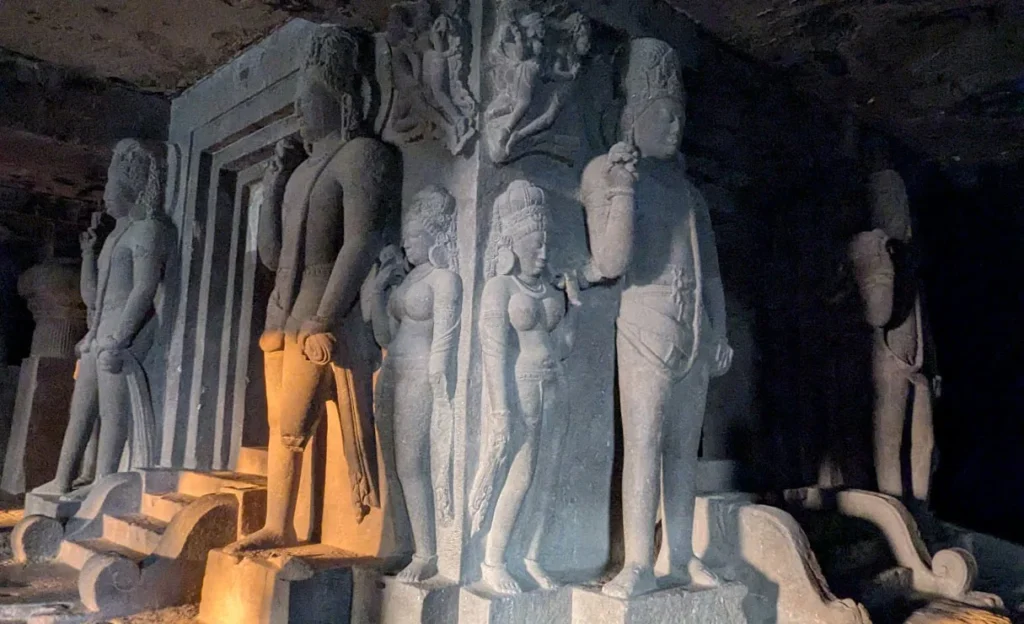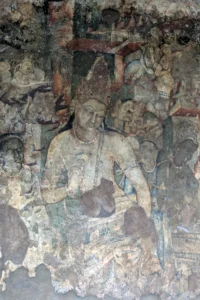Aurangabad
Aurangabad is the gateway to Ellora and Ajanta two of the most interesting historical sites in India. These 2000 year-old man-made caves were literally scooped out of solid rock by Buddhist monks who chose these sites for their seclusion. When the echo of the chisel faded, so did the world’s memory of the caves. Till the beginning of the 19th century, when a British hunting party discovered Ajanta, and the glory of the caves went on show for the world to see. These caves contain not only remarkable sculptures but also very well preserved wall paintings, many still glowing with their original colors. They are truly legends in stone and tributes to man’s devotion and triumph over nature.
ELLORA:
 About an hours from Aurangabad, Ellora represents to the world the finest and greatest in terms of sheer magnificence of Indian sculpture. The awe-inspiring, mammoth Kailash Temple is carved out of solid rock, dedicated to Mount Kailash of the Himalayas, the abode of Lord Shiva. This monolithic structure is a very rare phenomenon that demanded the most careful planning, based not on what was added but what was removed! is one of the world’s largest and massive sculptures. The Ramayana and Mahabharata are also depicted here in carvings as also the many-faceted personality of Lord Shiva. Ellora is a repository of Buddhist, Hindu and Jain religious expression, a sheer volume of information in carved pageantry. The cave temples and monasteries at Ellora are excavated out of the vertical face of an escarpment. Extending in a linear arrangement, the Thirty-four shrines synthesize Indian religion and Indian passion for sculpture containing Buddhist Chaityas, or halls of worship, and Viharas, or monasteries, Hindu and Jain temples. Spanning a period of about 600 years between the 5th & 11th century AD, the earliest excavation here is of Dhumar Lena (cave 29). The Kailash Temple of the Ellora caves is the most attractive and masterpiece of the creator. Ellora is a priceless page out of history, and the Ellora Caves are listed in the world-heritage list. Cave number 32 is famous for a glorious Yakshi statue and beautiful ceiling paintings.
About an hours from Aurangabad, Ellora represents to the world the finest and greatest in terms of sheer magnificence of Indian sculpture. The awe-inspiring, mammoth Kailash Temple is carved out of solid rock, dedicated to Mount Kailash of the Himalayas, the abode of Lord Shiva. This monolithic structure is a very rare phenomenon that demanded the most careful planning, based not on what was added but what was removed! is one of the world’s largest and massive sculptures. The Ramayana and Mahabharata are also depicted here in carvings as also the many-faceted personality of Lord Shiva. Ellora is a repository of Buddhist, Hindu and Jain religious expression, a sheer volume of information in carved pageantry. The cave temples and monasteries at Ellora are excavated out of the vertical face of an escarpment. Extending in a linear arrangement, the Thirty-four shrines synthesize Indian religion and Indian passion for sculpture containing Buddhist Chaityas, or halls of worship, and Viharas, or monasteries, Hindu and Jain temples. Spanning a period of about 600 years between the 5th & 11th century AD, the earliest excavation here is of Dhumar Lena (cave 29). The Kailash Temple of the Ellora caves is the most attractive and masterpiece of the creator. Ellora is a priceless page out of history, and the Ellora Caves are listed in the world-heritage list. Cave number 32 is famous for a glorious Yakshi statue and beautiful ceiling paintings.
AJANTA:  About three hours from Aurangabad lies Ajanta – a series of caves, hewn out of rock by Buddhist monks who found sanctuary here and left a legend for posterity. These 30 caves with 24 monasteries and 5 temples have wall paintings and sculpture of an aesthetic appeal that is timeless. The craftsmanship astounds scholars and art lovers even today. Some of the most exquisite paintings depict the life and teachings of Buddha as well as his earlier life as a prince. The Ajanta caves are like chapters of a splendid epic tale in visual form. Natural light brightens the caves at different times of the day leaving visitors awe-struck by the sheer brilliance of those ancient masters who created this marvel of art and architectural splendor. The Ajanta Caves are a group of 30 rock cut Buddhist caves. The basic designs of the caves are called ‘Chaitya grihas’ and ‘Viharas’. Five caves are Buddhist cathedrals & the remaining 25 are monasteries. The Chaityas are large, rectangular chambers separated by rows of pillars. They are decorated by sculptures and murals which depict the many incarnations of Buddha. The Viharas are rectangular shaped halls. They have series of small cells which are attached on both sides. Opposite to the entrance is an image of Buddha. The caves also include a visual form of the life of Buddha and interesting stories from latakas. The monument of Bibi Ka Maqbara is widely known as the ‘Poor man’s Taj’ was built in 1679 AD by Aurangzeb’s son, built it in memory of his mother Rabia. Ata Ullah was the architect and he based the design on the Taj Mahal. The memorial is built of sandstone with plastered walls and has a marble dome. It has an flowery wall around with an entrance which provides the best view of the memorial. The enclosure of the tomb is made of marble and is octagonal. Ajanta Caves declared as World heritage site by UNESCO
About three hours from Aurangabad lies Ajanta – a series of caves, hewn out of rock by Buddhist monks who found sanctuary here and left a legend for posterity. These 30 caves with 24 monasteries and 5 temples have wall paintings and sculpture of an aesthetic appeal that is timeless. The craftsmanship astounds scholars and art lovers even today. Some of the most exquisite paintings depict the life and teachings of Buddha as well as his earlier life as a prince. The Ajanta caves are like chapters of a splendid epic tale in visual form. Natural light brightens the caves at different times of the day leaving visitors awe-struck by the sheer brilliance of those ancient masters who created this marvel of art and architectural splendor. The Ajanta Caves are a group of 30 rock cut Buddhist caves. The basic designs of the caves are called ‘Chaitya grihas’ and ‘Viharas’. Five caves are Buddhist cathedrals & the remaining 25 are monasteries. The Chaityas are large, rectangular chambers separated by rows of pillars. They are decorated by sculptures and murals which depict the many incarnations of Buddha. The Viharas are rectangular shaped halls. They have series of small cells which are attached on both sides. Opposite to the entrance is an image of Buddha. The caves also include a visual form of the life of Buddha and interesting stories from latakas. The monument of Bibi Ka Maqbara is widely known as the ‘Poor man’s Taj’ was built in 1679 AD by Aurangzeb’s son, built it in memory of his mother Rabia. Ata Ullah was the architect and he based the design on the Taj Mahal. The memorial is built of sandstone with plastered walls and has a marble dome. It has an flowery wall around with an entrance which provides the best view of the memorial. The enclosure of the tomb is made of marble and is octagonal. Ajanta Caves declared as World heritage site by UNESCO
